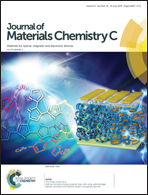Controllable supramolecular chain aggregation through nano-steric hindrance functionalization for multi-color larger-area electroluminescence†
Abstract
Suppression of hierarchical chain aggregation in light-emitting π-conjugated polymers (LCPs) is significant for restraining long-wavelength emission and improving the device performance. Herein, for the inhibition of molecular aggregation and the enhancement of luminescence efficiency, a series of multi-dimensional nano-steric units were introduced into supramolecular polyfluorene (PPFOH) by copolymerization, with the aim of integrating the advantages of the nano-steric hindrance effect on molecular emission. The introduction of our nano-steric units can not only effectively disrupt interchain hydrogen-bonding interaction and aggregation but also allow for excellent self-assembly behavior to form zero (nanosphere) and one-dimensional nanowires, similar to DNA molecules. Moreover, the long-wavelength emission at 500–590 nm of PPFOH can be effectively suppressed upon increasing the size and dimension of nano-steric units. Furthermore, larger-area polymer light-emitting diodes (PLEDs) (4 × 4 cm) are fabricated with a tunable electroluminescence (EL) color from orange to yellow, green and blue. These results indicated that nano-steric-hindrance functionalization is a superior and convenient approach to inhibit the interchain aggregation, tune the self-assembly behavior and improve the optoelectronic properties of LCPs.



 Please wait while we load your content...
Please wait while we load your content...